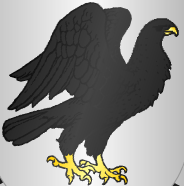The
Ant That Killed a Lion
Richard
the Lionheart is one of England’s best remembered kings. Though he did nothing
much for anyone, certainly not for
England, where he hardly spent any time at all, he managed to attract a lot of
attention, enough to become a legend. This was probably because he was said to
be very tall and well-proportioned, and golden-haired and good-looking, and was the favorite son of the
flamboyant Eleanor of Aquitaine and had
a romantic halo about him. The fact that minstrels liked to write verses about
him and that he wrote verses himself and got mixed up with the story of Robin
Hood and went off on a Crusade and had
Saladin for an honorable rival also helped to feed his legend. But Richard was by no
means a nice person. He was known to have been too often brutal with those that
opposed him. Three persons Richard had dealt unfairly with were the father and
the brothers of a youth of no great importance whose name may have been Bertram
de Gourdon. Richard had caused the death of the three men and Bertram, in
revenge, shot the king with a crossbow. The wound became gangrenous and when
Richard saw he was about to die he asked to see his murderer. When the boy explained to the king why he had
shot him, Richard decided to do one last good deed. He pardoned the boy,
asked his men to allow Bertram to go in peace, and even gave him 100 shillings.
The king’s men, however, took no heed of
the dying king’s last act of chivalry. Poor Bertram was cruelly executed as
soon as Richard died in his mother’s arms. Hence the saying “the Lion by the
Ant was slain.”
La hormiga que mató a un león
Ricardo
Corazón de León es uno de los reyes más recordados de Inglaterra, aunque no
hizo gran cosa por ese país, ya que apenas pasó tiempo allí. Pero aun así consiguió
atraer suficiente atención como para llegar a ser una leyenda. Eso se debe
probablemente a que era de buen ver, alto y bien proporcionado, con el pelo
dorado de un león, y a que era el hijo favorito de la flamante Leonor de
Aquitania. También tenía un halo romántico porque a los trovadores les gustaba
componer versos sobre él, y él mismo componía versos y hasta se vio involucrado
en las historias sobre Robín de los Bosques y fue cruzado y tuvo por honorable rival
nada menos que a Saladino. Pero Ricardo no era en realidad una persona digna de
admiración. Podía ser brutal con aquellos que se oponían a él. Tres hombres que
sufrieron por culpa de Ricardo fueron el padre y los hermanos de un joven de escasa importancia posiblemente
llamado Beltrán de Gourdón. Ricardo fue la causa de la muerte de los tres, y
para vengarse de él, Beltrán le disparó con una ballesta. La herida se gangrenó
y cuando Ricardo vio que iba a morir, pidió ver a su asesino. Cuando el
muchacho explicó por qué había disparado al rey, Ricardo decidió hacer una
última buena obra. Perdonó al chico, pidió a sus hombres que le dejasen marchar
en paz y hasta le dio cien chelines. Los hombres del rey, sin embargo, no
cumplieron la última voluntad de su soberano y este último acto de caballerosidad
de nada sirvió. Beltrán fue ejecutado cruelmente en cuanto Ricardo murió en
brazos de su madre. A esta historia se debe el dicho “el león por la hormiga
fue muerto.”
I
–Answer these questions:
1.
Was Richard one of England’s best kings?
2.
What did Richard look like?
3.
Was Richard a Crusader?
4.
Who was Richard’s most famous noble enemy?
5.
Was the boy who shot Richard called Bertram?
6.
Why did Bertram want revenge?
7.
How did Bertram kill Richard?
8.
What did Richard try to do for Bertram on his deathbed? Did he succeed?
9.
Who was with Richard when he died?
10. Why do people still say that an ant killed a
lion when they speak of this episode?
I - Responde a estas preguntas:
1.
¿Fue Ricardo uno de los mejores reyes de Inglaterra?
2.
¿Qué aspecto tenía Ricardo?
3.
¿Participó Ricardo en las cruzadas?
4.
¿Quién fue el adversario más famoso de Ricardo?
5.
¿Se llamaba Beltrán el muchacho que mató a Ricardo?
6.
¿Por qué buscaba Beltrán venganza?
7.
¿Cómo mató Beltrán a Ricardo?
8.
¿Qué intentó hacer Ricardo por Beltrán en su lecho de muerte? ¿Lo consiguió?
9. ¿Quién estaba con Ricardo cuando este
murió?
10. ¿Por qué sigue diciendo la gente eso de que
una hormiga mató a un león cuando se habla de este incidente?
II
– Match these words with their meanings:
1. 1.good-looking ____a. a kind of money
2. 2.shilling ____b. aura
3. 3.halo ____c. nice to look at
4. 4.flamboyant ____d. killed
5. 5.slain ____e. colurful, eccentric and showy
6. 6.minstrel ____f.
troubadour
7. 7.heed ____g. badly
infected
8. 8.revenge ____h. a famous Muslim king
9. 9.gangrenous ____i. pay attention to, obey
10.Saladin ____j. vengeance
II II– Empareja estas palabras con sus significados:
1. 1. de buen ver ____a.
un tipo de dinero
2. 2. chelín ____b. aureola
3. 3. halo ____c. bien parecido
4. 4. flamante ____d. asesinado
5. 5. muerto ____e. vistoso, excéntrico, llamativo
6. 6. trovador ____f. músico y poeta medieval
7. 7. cumplir con ____g. grave infección
8. 8. revancha ____h. un famoso rey musulmán
9. 9. gangrena ____i.
prestar atención
1 10. Saladino ____j. venganza
Featured in this post /
Figuran en esta entrada
Bertram de Gourdon / Beltrán de Gourdón

Saladin / Saladino
Eleanor of Aquitaine /Leonor de Aquitania
Richard the Lionheart /Ricardo Corazón de León






















.jpg)













